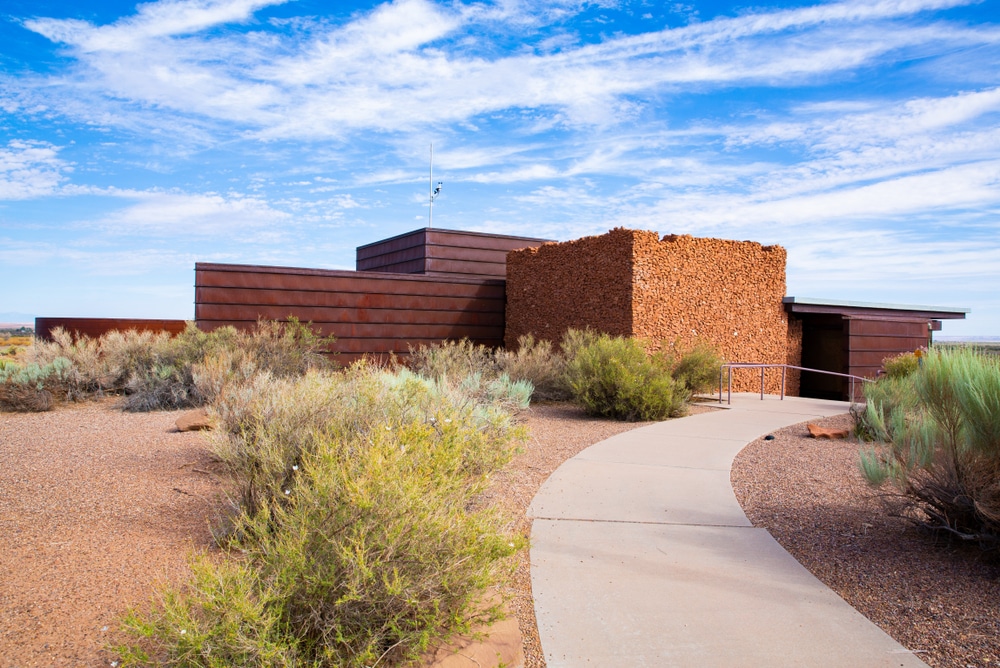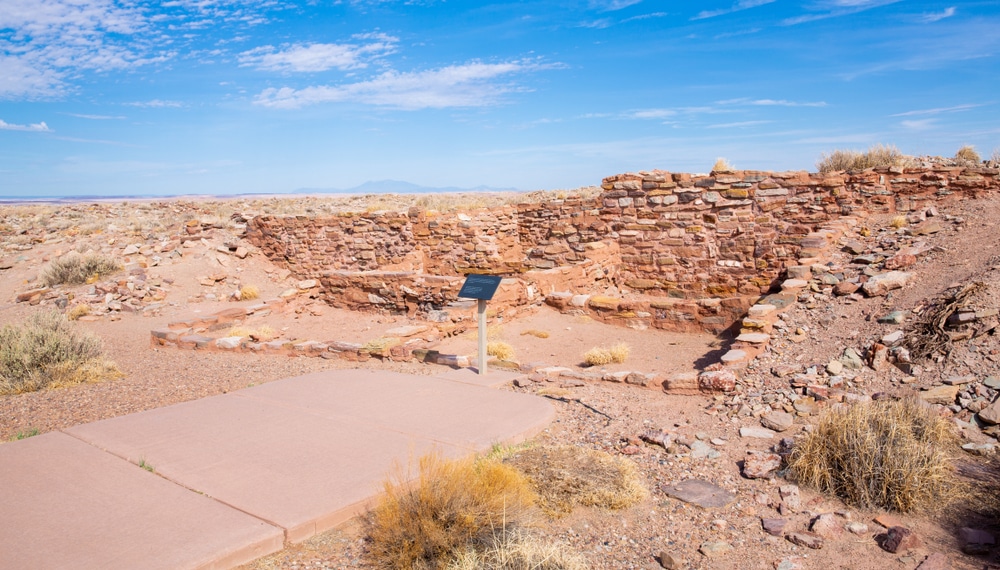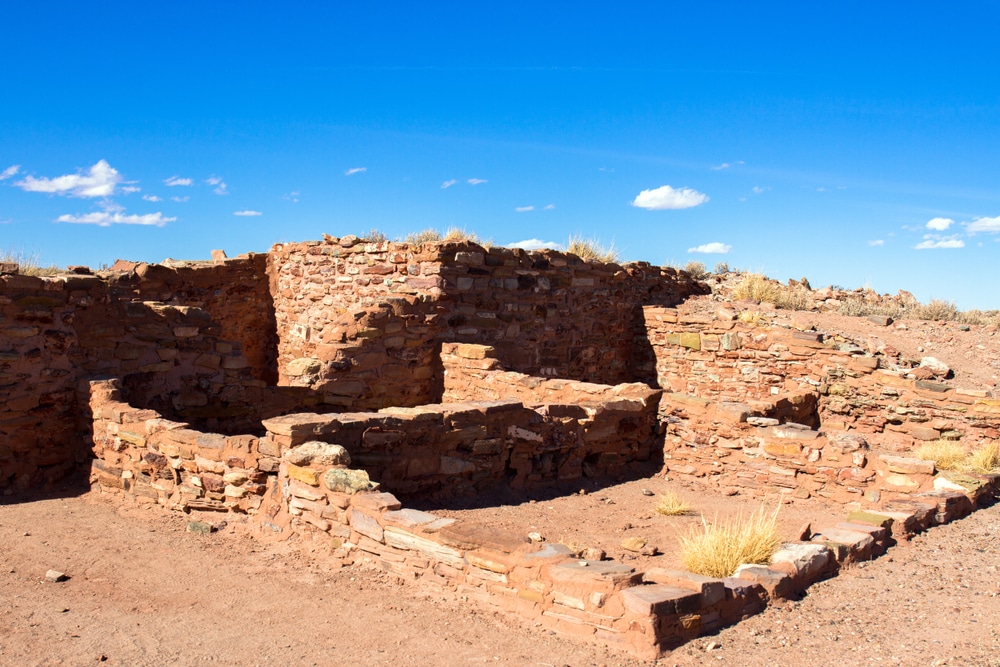Nestled in the high desert landscape of northeastern Arizona, Homolovi State Park stands as a testament to the rich cultural heritage and archaeological significance of the region. The name “Homolovi,” meaning “Place of the Little Hills” in Hopi, refers to the traditional name for Winslow, Arizona, where the park is located. Established in 1986 in response to growing concerns about the vandalism and looting of important archaeological sites, this 4,500-acre park now serves as a vital center for research on the late migration period of the Hopi people from the 1200s to the late 1300s.
Located just over a mile north of Winslow off Interstate 40 (taking Exit 257 and heading north on Arizona State Route 87), Homolovi State Park sits at an elevation of 4,900 feet within the stunning Colorado Plateau. The park’s geographical setting along the fertile floodplains of the Little Colorado River provides visitors with sweeping vistas of the high desert grasslands and distant mountains, including views of the San Francisco Peaks to the northwest.

What makes Homolovi particularly significant within Arizona’s park system is its preservation of over 300 Ancestral Puebloan archaeological sites, offering an unparalleled window into the lives of those who inhabited this area centuries ago. The park’s establishment marked an important collaboration between the State of Arizona, the Hopi Tribe, and concerned citizens to protect these irreplaceable cultural resources. Today, while archaeologists study these sites in cooperation with the Hopi Tribe, visitors can explore this living cultural landscape and gain insights into the ancestral connections that continue to this day.


Homolovi State Park preserves the archaeological sites of several ancestral Puebloan villages dating from the 13th and 14th centuries. Visitors can walk among the partially excavated ruins of Homolovi I and Homolovi II, the largest of the park’s sites with over 1,200 rooms. Well-marked trails with interpretive signage guide visitors through these ancient settlements, explaining construction techniques, daily life activities, and the cultural significance of various structures.

The park’s visitor center houses an impressive museum featuring artifacts recovered from archaeological excavations at the Homolovi sites. Displays include remarkable pottery examples, tools, jewelry, and other items that illuminate the sophisticated material culture of the ancestral Hopi people. Interactive exhibits explain the chronology of settlement, agricultural practices, and eventual migration to the Hopi mesas.

One of the most distinctive features of Homolovi is the abundance of pottery fragments (sherds) visible on the ground surface. While collection is strictly prohibited, visitors can observe these artifacts in their original context, learning to identify different pottery styles and decorative techniques. Rangers provide guidance on responsible viewing practices to ensure preservation of these important cultural resources.
Homolovi holds special significance as an ancestral site for the Hopi people, who consider the villages part of their migration history. Interpretive materials throughout the park share Hopi perspectives on the significance of these places. During special events, Hopi cultural demonstrators sometimes offer presentations on traditional crafts, storytelling, and the continuing relationship between modern Hopi communities and Homolovi.

Several trails wind through the park, ranging from short interpretive loops around the archaeological sites to longer paths exploring the natural landscape. The Sunset Trail offers panoramic views of the Little Colorado River valley and distant mesas, while the Tsu’vö Trail connects several significant cultural features. These routes showcase both the cultural and natural resources that make Homolovi unique.

Located along the Little Colorado River, Homolovi attracts diverse bird species in an otherwise arid environment. Birdwatchers can observe both desert species and those drawn to the riparian corridor. Golden eagles, prairie falcons, Say’s phoebes, and numerous migratory species can be spotted throughout the year. The park provides bird checklists to help visitors identify local and seasonal species.

The park maintains 53 developed campsites accommodating tents and RVs with electric and water hookups available. Each site includes a picnic table, fire ring, and shade ramada. The campground features modern restrooms with hot showers and offers spectacular views of the surrounding landscape. The dark night skies make it an excellent base for stargazing activities.
Water activities at Homolovi are limited due to the intermittent and often minimal flow of the Little Colorado River along the park’s western boundary. However, for those seeking water recreation, McHood Park and Clear Creek are located a short drive south of Winslow and offer canoeing, fishing, swimming, and picnicking opportunities. Clear Creek Canyon provides a beautiful, secluded environment for paddling and exploring a deep canyon landscape that contrasts with the open vistas of Homolovi.
Fishing enthusiasts will find better opportunities at nearby Clear Creek rather than within the park itself. The Little Colorado River within the park boundaries typically doesn’t maintain sufficient water levels for reliable fishing. At Clear Creek, anglers can pursue various fish species including catfish, sunfish, and occasionally trout (depending on stocking schedules). Arizona fishing regulations apply, and a valid Arizona fishing license is required for anyone 10 years of age or older. Licenses can be purchased online through the Arizona Game and Fish Department or at various retailers in Winslow.
Hiking is one of the primary activities within Homolovi State Park, with several trails offering different experiences and difficulty levels:
Photography enthusiasts will find numerous compelling subjects throughout the park. The archaeological sites provide fascinating foreground elements against the expansive landscape vistas. Dawn and dusk offer the most dramatic lighting conditions, with the low-angle sunlight highlighting the textures of the pueblo walls and the surrounding terrain. The panoramic views from higher points in the park, particularly looking toward the distant San Francisco Peaks, create stunning photographic opportunities. Wildlife photography is also rewarding, especially for those patient enough to wait for birds of prey or coyotes to appear.
Stargazing is exceptional at Homolovi due to its remote location and minimal light pollution. The park hosts regular star parties at its Winslow Homolovi Observatory, equipped with telescopes including a Celestron CGE Pro 14-inch Schmidt-Cassegrain telescope capable of locating over 40,000 celestial objects. Monthly astronomy events are held throughout the year, with special programs during significant astronomical events. Even without specialized equipment, the night sky visibility is remarkable, making it a perfect location for astrophotography or simply enjoying the brilliant display of stars, planets, and the Milky Way.

| Category | Details |
|---|---|
| Location | Winslow, Arizona, USA (approximately 5 miles northeast of Winslow) |
| Area | 4,000 acres (1,619 hectares) |
| Established | As a state park in 1993 |
| Elevation | Approximately 4,900 feet (1,494 m) |
| Cultural Significance | Preserves archaeological sites of the Ancestral Puebloan people (Hisatsinom) |
| Archaeological Features | Four major pueblos dating from approximately 1260-1400 CE |
| Primary Ruins | Homolovi I, Homolovi II, Homolovi III, and Homolovi IV pueblos |
| Namesake | “Homolovi” means “Place of the Little Hills” in the Hopi language |
| Hopi Connection | Ancestral homeland of the Hopi people, who consider these sites sacred |
| Museum | Visitor center with exhibits on Hopi culture, archaeology, and regional history |
| Trails | Several interpretive trails to archaeological sites, ranging from 0.25 to 1.5 miles |
| Primary Trail | Homolovi II Trail (1.5 miles) leading to the largest excavated pueblo |
| Wildlife | Desert cottontails, jackrabbits, coyotes, pronghorn, various reptiles and birds |
| Plant Life | High desert vegetation including juniper, sagebrush, Mormon tea, yucca |
| Camping | 53 campsites with water and electric hookups, suitable for RVs and tents |
| Facilities | Visitor center, museum, campground, picnic areas, restrooms, showers |
| Recreation | Hiking, wildlife viewing, stargazing, cultural/archaeological education |
| Astronomy | Designated dark sky site with periodic star parties and astronomy programs |
| Annual Events | Suvoyuki Day (August) celebrating Hopi culture and ancestral sites |
| Nearby Features | Little Colorado River, Painted Desert, Clear Creek |
| Notable Artifacts | Pottery, stone tools, trade items showing cultural connections with other regions |
| Management | Arizona State Parks in partnership with the Hopi Tribe |
| Distance from Flagstaff | Approximately 60 miles (97 km) east |
| Unique Feature | One of the most significant archaeological preserves in the Southwest |
| Cultural Practices | Active partnership with Hopi people who return for ceremonies and pilgrimages |
The landscape of Homolovi State Park is characterized by its high desert terrain, featuring rolling grasslands, scattered juniper trees, and small hills or mesas. The park encompasses over 4,000 acres of the upper Sonoran grassland ecosystem, providing a stark but beautiful backdrop for the archaeological treasures contained within.
The Little Colorado River forms the western boundary of the park, carving its path through the arid landscape. This vital waterway has shaped both the physical environment and human history of the region. While the river’s flow varies seasonally, its presence has long supported life in this otherwise harsh environment. The river’s fertile floodplains were a key reason the ancestral Hopi people settled in this area, using the deposited driftwood for building and burning, and the rich soil for growing crops, particularly cotton.
The park sits at an elevation of 4,900 feet, placing it within a transition zone between lower desert environments and the higher mountain regions of northern Arizona. This elevation contributes to the park’s climate, with hot summers, cold winters, and generally low precipitation—a typical high desert environment.
Notable geological formations within the park include the small mesas where some of the pueblos were constructed, offering strategic views of the surrounding landscape. The sandy soil throughout the park bears witness to the region’s ancient geological history as part of a much larger seabed millions of years ago.
The Little Colorado River watershed, of which Homolovi is a part, extends across much of northeastern Arizona, eventually joining the Colorado River near the Grand Canyon. This watershed has been instrumental in shaping the topography of the region, cutting through layers of sandstone and other sedimentary rock to create the distinctive landscape seen today. The watershed remains ecologically important, supporting diverse plant and animal communities adapted to the arid conditions.
The park’s location on the Colorado Plateau places it within one of North America’s most geologically fascinating regions, characterized by relatively undisturbed sedimentary layers that reveal millions of years of Earth’s history. These geological features have not only shaped the physical environment but also influenced how humans have interacted with this landscape throughout time.
Homolovi State Park’s high desert ecosystem supports a surprising diversity of plant and animal life, all adapted to survive in the sometimes harsh conditions of northeastern Arizona. The park’s elevation at 4,900 feet places it within the upper Sonoran grassland biome, creating a unique ecological setting with distinct seasonal patterns.
The native plant species found throughout the park reflect adaptations to the arid climate and sandy soil conditions. Visitors will encounter:
During spring months, particularly after winter precipitation, the landscape can transform with wildflowers including desert marigold, globemallow, and prickly pear blossoms. The vegetation tends to be more concentrated near the Little Colorado River, where increased moisture supports a greater diversity of plant life.
Wildlife viewing opportunities abound at Homolovi, with the expansive grasslands providing habitat for numerous species. The park is particularly known for its excellent raptor viewing, with golden eagles, northern harrier hawks, red-tailed hawks, American kestrels, and burrowing owls regularly spotted soaring above or perched in the landscape. Other bird species include ravens, roadrunners, and various grassland birds such as horned larks. Birdwatchers will find the park especially rewarding during migration seasons when additional species pass through the area.
Mammals that inhabit the park or may be seen during visits include:
Smaller mammals like ground squirrels and various rodent species are also common. While more elusive, bobcats and mountain lions occasionally traverse parts of the park.
Reptiles are well-represented in this ecosystem, with several species of lizards including collared lizards basking on rocks during warmer months. Visitors should be aware that rattlesnakes, particularly the Western diamondback, are native to the area and may be encountered, especially during early morning or evening hours in summer when they may warm themselves on park roads or trails.
The park experiences significant seasonal ecological changes throughout the year:
These seasonal shifts create different viewing opportunities throughout the year.
Conservation efforts within the park focus on maintaining this delicate desert ecosystem, protecting not only the archaeological resources but also the plants and animals that contribute to the ecological balance of the region. Visitors play an important role in these efforts by staying on designated trails, observing wildlife from a distance, and following Leave No Trace principles.
Homolovi State Park offers a well-maintained campground set amid the high desert landscape, providing visitors with an immersive overnight experience under the same starry skies that the ancestral Puebloans once viewed. The campground accommodates various camping preferences and serves as an excellent base for exploring both the park and the surrounding area.
The campground features 53 developed campsites spread across a spacious layout that ensures privacy between sites. Most sites have both water and electrical hookups (primarily 30-amp service, with pull-through sites offering both 30-amp and 50-amp connections). Sites #7, 14, 16, 35, 40, 41, 42, 44, and 46 are designated as non-electric for those preferring a more primitive camping experience. The campground includes both back-in and pull-through sites that can accommodate large RVs (up to 83 feet in length). Each campsite is equipped with a picnic table and a fire ring/grill, though visitors should note that the fire rings at some sites are positioned relatively close to the road.
Campground amenities include:
While the campground does have some small trees planted throughout, they provide minimal shade, so campers should be prepared with their own shade structures during summer months. The open layout offers excellent views of the surrounding landscape and sky.
Beyond standard campsites, the park includes ten sites with designated tent pads for tent campers. However, Homolovi does not offer cabins or alternative lodging options within the park boundaries.
For those seeking alternative accommodations near the park, Winslow provides several options:
Camping regulations at Homolovi State Park include:
Camping reservations are highly recommended, especially for weekend stays or during peak spring and fall seasons. Reservations can be made up to one year in advance through the Arizona State Parks reservation system online or by calling 1-877-MY-PARKS (1-877-697-2757). There is a non-refundable $3.20 reservation fee per site. Same-day reservations can be made in person at the visitor center or by calling the park office at (928) 289-4106 before 4:45 PM. Important note: Homolovi State Park no longer accepts self-pay registrations for camping, and non-registered campers are not permitted to enter after hours.
Camping tips for Homolovi visitors include:
The campground’s elevation at 4,900 feet means cooler temperatures than lower desert locations, with winter camping requiring cold-weather gear as temperatures can drop below freezing.
Planning a successful visit to Homolovi State Park requires understanding its operating hours, seasonal considerations, and facilities to make the most of your experience at this culturally significant site.
The park is open year-round, with daily visitor center hours from 8:00 AM to 5:00 PM. Special holiday hours apply, with Thanksgiving and Christmas Eve operations reduced to 8:00 AM to 2:00 PM, and full closure on Christmas Day. The archaeological sites and trails close at dusk, while the campground remains accessible to registered campers 24 hours a day.
Entrance fees help maintain park operations and protect the cultural resources:
Camping fees (additional to entrance fees):
Arizona State Parks annual passes are available and can provide good value for frequent visitors to the state park system.
The best times to visit Homolovi depend on your tolerance for temperature extremes:
Weather patterns in this high desert environment are characterized by significant daily temperature fluctuations, with cool mornings warming rapidly after sunrise and quick cooling after sunset. The region receives limited precipitation, with brief thunderstorms possible during the summer monsoon season (July-September) and occasional winter snowfall. Strong winds are common throughout the year, particularly in spring, so securing tents and awnings properly is essential for campers.
Accessibility information is important for visitors with mobility considerations:
Pet policies allow leashed pets (six-foot leash maximum) in the campground and on trails. Pets are not permitted inside park buildings, including the visitor center and museum. Owners must clean up after their pets, and animals should never be left unattended, particularly given the potential for extreme temperatures.
Cell service and internet availability can be limited within the park. Most major carriers provide at least basic coverage near the visitor center and campground, but service may be spotty or unavailable in more remote areas of the park. The visitor center does not offer public Wi-Fi, though the nearby town of Winslow has various locations with internet access. This limited connectivity offers visitors a chance to disconnect and fully immerse themselves in the park’s cultural and natural environment.
Homolovi State Park provides visitors with a range of modern facilities while maintaining the serene and culturally significant atmosphere of this historic landscape.
The Visitor Center serves as the hub of park operations and is typically the first stop for most visitors. Open daily from 8:00 AM to 5:00 PM (except Christmas Day, with limited hours on Thanksgiving and Christmas Eve), this fully accessible facility offers:
Restroom and shower facilities are available in the campground area. These modern amenities include flush toilets, sinks with running water, and hot showers. The facilities are cleaned regularly and are accessible to visitors with mobility limitations. While the park provides the shower facilities, campers should bring their own toiletries. During renovation periods (scheduled for July through September 2025), portable toilets and showers will be available as alternatives.
Picnic areas with shade ramadas are strategically placed throughout the park. Several covered picnic tables are located at the visitor center and intermittently along the road to Homolovi II. These designated areas provide welcome respite from the sun and comfortable spaces for meals while enjoying views of the surrounding landscape. Each picnic site typically includes a table and nearby trash receptacles, with some offering grills for cooking.
The park features several specialized recreation areas beyond the main archaeological sites:
Concessions and stores within the park are limited to the gift shop in the visitor center, which offers books, Hopi crafts, jewelry, and basic souvenirs. For groceries, camping supplies, or other necessities, visitors should stock up in Winslow before entering the park. Winslow provides various shopping options including grocery stores, pharmacies, and specialty shops, many located along historic Route 66 or near Interstate 40.
Homolovi State Park’s location in northeastern Arizona places it within reach of several notable attractions, making it an excellent base for exploring this distinctive region of the Southwest.
Other parks and natural areas within driving distance include:
Local towns and communities worth exploring include:
Cultural and historical sites in the region include:
Recommended local businesses and services include:
Homolovi State Park stands as a testament to successful conservation efforts born from public concern about the protection of invaluable archaeological resources. The park’s establishment in 1986 came in direct response to widespread vandalism and looting of the Homolovi sites, which reached a devastating peak in the 1960s when mechanical equipment was used to loot burials and ceremonial structures.
Park conservation efforts focus on preserving both the cultural and natural resources within its boundaries. These efforts include:
Visitor responsibilities play a crucial role in the continued preservation of Homolovi’s irreplaceable resources. All visitors are asked to:
Volunteer opportunities exist for those wishing to contribute more actively to the park’s mission. These include:
Educational programs offered at Homolovi provide deeper understanding of both cultural and natural history:
Leave No Trace principles are particularly emphasized at Homolovi, given the fragile nature of both archaeological resources and desert ecosystems:
Through these combined efforts of park staff, volunteers, and responsible visitors, Homolovi State Park continues to fulfill its mission of protecting an irreplaceable window into the past while providing meaningful educational experiences for present and future generations.
We use cookies to improve your experience on our site. By using our site, you consent to cookies.
Manage your cookie preferences below:
Essential cookies enable basic functions and are necessary for the proper function of the website.